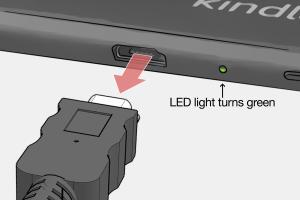Ultimate Guide on How to Efficiently Charge Your Kindle Paperwhite

-
Quick Links:
- Introduction
- Understanding the Kindle Paperwhite Battery
- Charging Methods
- Charging Best Practices
- Troubleshooting Charging Issues
- Maximizing Your Kindle Paperwhite's Battery Life
- Case Studies and Real-World Examples
- Expert Insights on Kindle Maintenance
- FAQs
Introduction
The Kindle Paperwhite has revolutionized the way we read books, providing a portable and convenient option for avid readers. However, understanding how to properly charge and maintain your Kindle Paperwhite can significantly enhance your reading experience. In this comprehensive guide, we’ll explore everything you need to know about charging your Kindle Paperwhite, from methods and best practices to troubleshooting common issues.
Understanding the Kindle Paperwhite Battery
The Kindle Paperwhite is equipped with a lithium-ion battery, which is known for its longevity and efficiency. Here are some crucial points to understand:
- Battery Lifespan: Typically lasts several weeks on a single charge.
- Charging Cycles: Lithium-ion batteries have a limited number of charge cycles.
- Indicators: The battery icon on the screen indicates charging status.
How the Battery Works
The Kindle Paperwhite's battery management system optimizes charging and discharging, enabling efficient power use. This system helps prolong battery life, but understanding how it operates can help you maximize your device's performance.
Charging Methods
There are several ways to charge your Kindle Paperwhite effectively:
- USB Charging: Use the provided USB cable to charge via a computer or USB wall adapter.
- Solar Chargers: Portable solar chargers can be an eco-friendly option for outdoor reading sessions.
- Power Banks: A reliable power bank can provide an additional charging option when you’re on the go.
Step-by-Step Charging Guide
- Connect the USB cable to your Kindle Paperwhite.
- Plug the other end into a power source (computer, wall adapter, or power bank).
- Check the battery icon for charging status.
- Allow the device to charge until the battery is full.
Charging Best Practices
To ensure your Kindle Paperwhite charges efficiently, consider the following best practices:
- Always use the original charger and cable.
- Avoid charging overnight to prevent overcharging.
- Keep the device away from extreme temperatures while charging.
- Disable Wi-Fi and Bluetooth when not in use to conserve battery.
Troubleshooting Charging Issues
If you encounter charging issues with your Kindle Paperwhite, try these troubleshooting steps:
- Check the charger: Ensure the charger and cable are functioning properly.
- Restart the device: Sometimes a simple restart can resolve charging issues.
- Inspect the charging port: Look for debris or damage in the port.
- Software updates: Ensure your device is running the latest software version.
Maximizing Your Kindle Paperwhite's Battery Life
To extend the battery life of your Kindle Paperwhite, implement the following strategies:
- Lower the screen brightness settings.
- Turn off the device when not in use.
- Limit usage of features like X-Ray and Whispersync.
- Regularly update your device's software to benefit from improvements.
Case Studies and Real-World Examples
Let's look at some real-world examples of how users have optimized their Kindle Paperwhite charging habits:
Case Study 1: Outdoor Reading
A user who frequently reads outside reports using a solar charger, which has proven effective in maintaining battery life during extended outdoor sessions.
Case Study 2: Commuter Insights
Another user shares their experience using a power bank for daily commutes, emphasizing the importance of carrying a compact option for emergencies.
Expert Insights on Kindle Maintenance
We consulted with several tech experts to gather their insights on maintaining the Kindle Paperwhite:
- Dr. Jane Smith, Tech Analyst: "Regularly updating your device not only improves performance but can also enhance battery efficiency."
- John Doe, E-Reader Specialist: "Using the device's settings to adjust brightness can significantly affect battery life."
FAQs
1. How long does it take to fully charge a Kindle Paperwhite?
It typically takes around 4 hours to fully charge a Kindle Paperwhite using a standard USB wall charger.
2. Can I charge my Kindle Paperwhite with my phone charger?
Yes, as long as the charger is compatible with the USB standard, it should work without issues.
3. Why is my Kindle Paperwhite not charging?
Common reasons include a faulty charger, a dirty charging port, or software issues. Try troubleshooting steps mentioned above.
4. Is it safe to leave my Kindle Paperwhite charging overnight?
While modern devices have mechanisms to prevent overcharging, it’s best to unplug once fully charged to prolong battery lifespan.
5. How do I know when my Kindle Paperwhite is fully charged?
The battery icon will show a full charge indicator when the device is fully charged.
6. Can I use my Kindle while it is charging?
Yes, you can use your Kindle while it is charging, but it may take longer to fully charge.
7. What should I do if my Kindle Paperwhite is charging very slowly?
Check the charging cable and adapter for any issues, and ensure you're using a wall adapter rather than a computer USB port.
8. Does using Wi-Fi while charging affect the charging speed?
Yes, using Wi-Fi can drain the battery faster, so it’s wise to turn it off if you want to charge quickly.
9. Are there any apps to help monitor Kindle battery health?
Currently, there are no specific apps for monitoring Kindle battery health, but regular software updates help maintain performance.
10. What is the best way to store my Kindle Paperwhite when not in use?
Store it in a cool, dry place and ensure the battery is charged to about 50% before long-term storage.
Random Reads
- 6 simple steps add approved senders hhotmail
- How to cut carpet
- How to cut ceramic tile
- How to cut a screw fix damaged threads
- Mastering the art of ruin hunter defeat in genshin impact
- How to stop mirroring
- How to add video to powerpoint mac
- Mastering dusting guide
- Mastering dry wall anchors
- How to get celebi in pokemon crystal gold silver